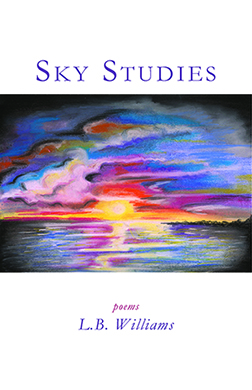 |
Comment on this
article

Sky Studies
by L.B. Williams
20 Poems/ 21 Pages/ $14.00
Finishing Line Press
www.finishinglinepress.com
Reviewed by: Ed Bennett
Part of the allure of poetry is its effect on the senses. Primary among these effects are hearing. The structure of a poem, its rhythm, meter and rhyme all collaborate with the sense of hearing for a pleasurable experience not found in prose. Born with repetitious beating of the Homeric staff to accentuate his hexameters, poetry’s effect on a reader’s ears varies from Poe’s tintinnabulations to Langston Hughes’ jazz lyrics to the work of Joy Harjo gleefully interspersing her verse with riffs from her own saxophone. Poetry is married to our ear in a way that few prose pieces can be. Even the greatest of our novelists are sometimes referred to as “poetic”.
As important as the auditory effect of a poem, however, is the sense that allows a poet to create this flow of pleasing words that we call a poem. No poet can create these well-wrought allusions and images unless they can see the world around them and fashion them into a unique vision that the words translate to the reader. Vision is essential for the poet yet its uniqueness resides in the creative process within. William Wordsworth wrote “Composed Upon Westminster Bridge, September 3, 1802” where London was a city of dazzling light wearing the beauty of dawn like a garment. William Blake wrote “London” in 1794, virtually at the same time, yet his vision is much darker with the suffering of the populace foremost in his vision. Two views, two different poets, two works that have remained with us for over two centuries despite their disparities.
L.B. Williams’ latest work, Sky Studies, offers us her vision of her universe from a different perspective. In her poem “Second Grade” she speaks of color – how her teachers wore red “to hide their sagging”, her friend’s golden blonde hair contrasted to her “dirty blonde thin” locks. The world around her is colorful while she is dressed in a neutral brown with only a beige ribbon for an accessory. The observation is summed up in the final three lines:
“the librarian said I couldn’t take
out Little Women so when she wasn’t
looking I snuck it past the nice desk clerk.”
In the child’s experience, color hides some of the less attractive qualities of the people around her yet the plainness of her “colors” gives her the power of invisibility. The adults in the poem, for the most part, are authoritarian and block her from her goal of reading yet she finds a way around their obstacles, learning that there is more to someone than just the externals.
In the preface to this work, Maia Brami offers us an insight to Ms. Williams’ poetry:
“If the collection’s title encourages us to look upon the sky, its core is the Water element – sea, lake, rain, dew, leaves, humidity…where past, present and future are melted, mystery and answer, ancestral river in which one struggles in order to keep following the road”.
Water takes on a transcendent, almost mystical stance in her poems, reflecting the sky, memories and the perception that we will never really understand its meaning. In “One Should Know Winter”, she mourns the loss of an unborn child with an invocation straight out of Kenneth Grahame:
“The wind in the willow says something is dying
For me…
By the water I dream a child.
Waves and sand, gulls and turtles are formed.
Planets die only again to be formed.
Dust and rock, sand and water disappear...
Snow whitens the land in winter.
Reminds us that we are always dying.
These days make us long for sleep”
The child of her dream disappears, as all nature seems to be moving to some cosmic entropy where all that remains is the whiteness of sleep, the finality experienced by the “disappearance of her child.
“Poem with a first line from Tomas Transtromer”, a boy with a kite
“feels the water inside and outside him
reflecting the house on a hill
solitary as the blue night arrives
with the promise of rain.”
Both the title and the first line of the poem are interesting. She chooses a line from a poem by Transtromer, a poet known for his poetry on nature and the seasons. The first line of the poem is “The lake is a window into the earth.” Again, water is the prime element that leads to mental conjurings of home, the night sky and images too far away to perceive with our senses. Yet it is “the water inside and outside him” that is responsible for these images.
In the eponymous poem “Sky Studies” Ms. Williams tells us:
“There’s still so much I can’t discern -
How moon mists move
by way of water
through silver nights
behind sea darkened doors.”
Images of the sky, stars, clouds and even the Triboro Bridge seem to be reflected in the water element. The water reflects these images much like Newton’s mirror telescope reflected the universe into the eyes of those seeking Cosmic answers. The poet’s eye engenders each image, each question in a remarkably unique and coherent dance of the senses as the water flows eternally to the future. This is the vision of Blake and Wordsworth baptized in the metaphor of water by a poet/priest of unusually fine talent.
Sky Studies has a definitely spiritual tenor to its poetry yet the language is accessible. This is not a quick read by any means but I assure you that the time invested in each page will be worth it. It is a unique collection of fine poems with the ability to make a reader ponder the world around them with the sound of a brook running softly through every thought.
Return to:
|


